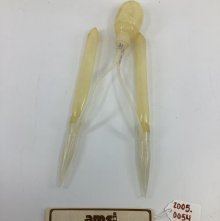Object Record
Images

Metadata
Object Name |
Prosthesis |
Object ID |
2005.0054 |
Description |
Inflatable penile implant cylinders, pump and fluid reservoir right angle connectors The first treatment for ED that became reasonably widespread among urologists was implantation of the Scott-Bradley-Timm inflatable prosthesis.This device, introduced in 1973, was the first to allow a man to have a prosthetic erection only when needed and to provide nearly natural flaccid and erect states. This implant would now be designated as a three-piece inflatable prosthesis: the three pieces being paired inflatable intracorporeal cylinders, a small scrotal pump and a large volume abdominal fluid reservoir. This device, constructed of silicone elastomer, was filled either with normal saline or isotonic contrast. In efforts to avoid implanting, this device in men with temporary or reversible ED, urologists began to learn how to take a good sexual history and to perform diagnostic testing.[14] It soon became apparent that ED, rather than almost always being due to psychological factors, was very frequently caused by organic disorders. This early inflatable penile prosthesis was associated with high mechanical failure rates ranging from 21 to 45% within a few years after implantation.[15-19] A variety of noninflatable and later simpler inflatable prostheses were developed as alternatives to the Scott-Bradley-Timm device. While not completely free of mechanical failure, many of these devices proved more reliable from this standpoint. |
Collection |
William P. Didusch Museum Collection |
Date |
1973 |
Artist/Designer |
Scott, Brantley |
Source |
Engel, Rainer, M.D. |
